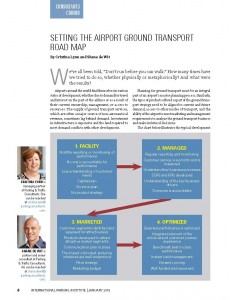
By Cristina Lynn and Shane de Wit
We’ve all been told, “Don’t run before you can walk.” How many times have we tried to do so, whether physically or metaphorically? And what were the results?
Airports around the world find themselves in various states of development, whether due to demand for travel and interest on the part of the airlines or as a result of their current ownership, management, or access to resources. The supply of ground transport services, which are often a major source of non-aeronautical revenue, sometimes lag behind demand. Investment in infrastructure is expensive and the land required to meet demand conflicts with other development.
Planning for ground transport must be an integral part of an airport’s master planning process. Similarly, the types of products offered as part of the ground transport strategy need to be aligned to current and future demand, access to other modes of transport, and the ability of the airport to meet marketing and management requirements to analyze the ground transport business and make informed decisions.
The chart below illustrates the typical development journey for airport parking and provides a roadmap of the potential journey airports might consider.
The development road map illustrates the steps that can be taken to advance the business. Each step provides the foundation of the next step in the journey, helping the business prioritize initiatives.
At the facility stage, a small regional airport may have identified the need to provide controlled or paid parking in the vicinity of the terminal, leaving long-term customers to park for free in informal areas further away. Lack of control will also mean lack of information about the customers’ current behaviors, length of stay, and car park occupancy. This makes planning for future growth difficult and does not give management a clear picture of the potential of the parking business. Parking is seen as a facility or, at best, a service that must be provided, instead of as an opportunity to enhance the customer’s airport experience and add to profitability.
A managed ground transport facility will have controlled parking areas that feature product definition (long term/short term/business/valet and associated areas for other transport options). Information produced by the access control system is reported upon by a dedicated person or team.
Progression to a marketed approach is marked by the identification of customer segments and development of specific product, pricing, and marketing strategies to attract business from other modes of transport. Regular market research is undertaken to gain customer insights and understand the key attributes that will attract customers. A strategic plan and marketing budget with a long-term view is developed. This entails understanding future demand and how and where parking will be delivered.
Airports that reach the optimized stage implement strategies to maximize the return from their parking assets by applying more sophisticated and technologically savvy strategies such as variable pricing, online booking engines, and high level of communication strategies with their customers. Yield management will ensure that the profitability of the parking business for the airport is maximixed. They clearly understand parking’s role as an integrated element of the passenger’s journey, and parking is incorporated with other areas of the airport. Technology is used to enhance the customer’s experience.
By adopting a strategic approach to the development of the parking and ground transport business, airports will ensure that they achieve ever-improving results and maintain a high level of customer service.
Cristina Lynn is managing partner of Parking & Traffic Consultants. She can be reached at cristina.lynn@parkingconsultants.com.
Shane de Wit is partner and senior consultant at Parking & Traffic Consultants. He can be reached at shane.dewit@parkingconsultants.com.
TPP-2015-01-Setting the Airport Ground Transport Road Map
